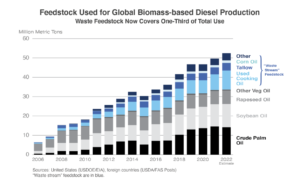The USDA is projecting that the ag trade deficit will shrink in FY2026 even more than previously anticipated. USDA expects the trade deficit to fall from $43.7 billion in FY2025…
FAS: “U.S. Soybean Meal Exports Expected to Reach Record High”
In a Trade Spotlight report yesterday, the USDA’s Foreign Agricultural Service (FAS) indicated that, “U.S. soybean meal exports set a record at an estimated 13.2 million tons in MY 2022/23 (Oct-Sep), valued at nearly $7 billion, driven by increased soybean crush to supply feedstock oil for growing U.S. biomass-based diesel production. The new record came from substantial expansion in shipments to the European Union and Vietnam as drought in Argentina, usually the world’s largest soybean meal exporter, severely reduced its exportable supplies. Additionally, U.S. soybean meal exports to the Philippines, Colombia, and Mexico held firm despite a strong dollar.

“In 2023/24, U.S. soybean meal exports are forecast to again reach a new record of 13.9 million tons. U.S. export prices are likely to remain competitive with South American supplies as the United States continues to produce more soybean meal than will be needed domestically, ensuring growing supplies are available to the global market.”

Bloomberg writers Chipman and Tarso Veloso Ribeiro reported yesterday that,
More soybeans are being processed as energy and agriculture companies look to profit from incentives to make cleaner burning fuel made from renewable sources such as farm crops.
“The production frenzy has led to a rush on soy oil, a key ingredient in green diesel. That in turn is leading to more soy meal, a commodity used to feed livestock. The trend is expected to continue. For the first time earlier this year, more US soy oil was used for biofuel production than food and other domestic uses.

“‘US exports of soybean meal should continue to expand as new soybean processing facilities come online over the next several years,’ said Scott Gerlt, chief economist for the American Soybean Association.”
Wall Street Journal writer Bob Henderson reported yesterday that, “Time was that soybean oil was a byproduct of the process used to extract protein-rich meal from the legume. Not anymore.
“The rising demand for oil is being driven by a booming industry that makes low-carbon diesel fuel from vegetable oils and animal fats.”

Henderson explained that, “A soybean’s meal, mostly used as a protein source in animal feed, and its oil are the two main products produced by crushing the plants. The increased demand for oil has led to an expansion of the country’s soybean crushing activity and, therefore, more meal available for export.”
Elsewhere, Dow Jones writer Kirk Maltais reported yesterday that, “Export inspections of U.S. soybeans continue to climb, driven by strong shipments of soybeans to China, according to Department of Agriculture data.
“Soybean export inspections totaled 2.46 million tons for the week ended Oct. 19, up from 2.04 million tons reported in the previous week. China was the key destination for U.S. soybean shipments – accounting for over 2 million tons sent there for the week.”
A separate Dow Jones article from yesterday reported that, “Soybeans for November delivery fell 1.2% to $12.87 a bushel on the Chicago Board of Trade on Monday, with South American growing areas receiving supportive rainfall for their crops.”
Reuters writer Naveen Thukral reported today that, “U.S. farmers had harvested three-quarters of their soybean crop and 59% of their corn by Sunday, according to weekly data from the U.S. Department of Agriculture (USDA) released on Monday.”
The Reuters article added that, “In Brazil, if expected rains come this week, it will improve prospects for soy farmers who have been sowing their new crop at a slower pace in unusually hot and dry weather, experts said.
“Heavy rains in Argentina drenched drought-hit agricultural regions over the weekend, which could benefit wheat crops ahead of harvesting and also boost corn planting.”





